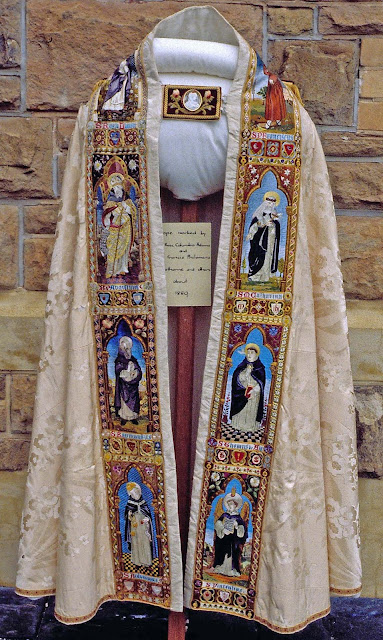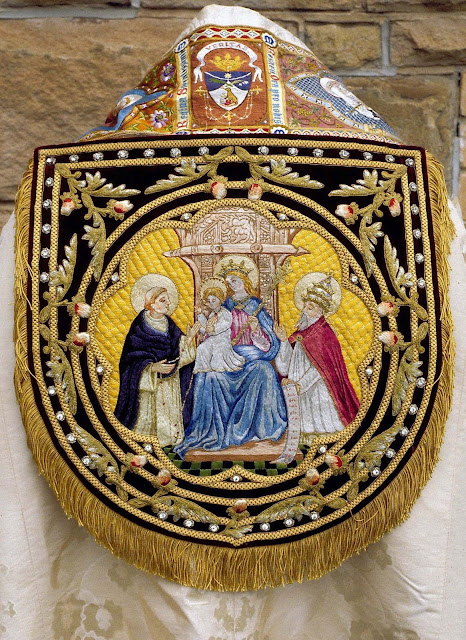Here's why I think it is important. First is variety. It just seems a terrible shame to think of any tradition being a closed door in which there is no possibility of something new. For all that we have much to draw from already, to see how mankind under inspiration can still create something previously unimagined is a wonderful thing. The seemingly limitless variety that is possible, points, I think to the limitless well of grace that is the ultimate source of that inspiration.
Second is that we need new expressions in order to attract more people. All the artistic traditions of the Church reflect timeless principles and so have something within them to which every person, potentially, can respond. Traditional chant and polyphony, or great art even in reproduction or original but pastiche, still has the power to touch many people and draw them into the Faith. The timeless principles that unite all good art and music will always have an effect. I speak from personal experience: I was bowled over by my experience of hearing Palestrina at the London Oratory. With a live performance in unity with liturgy, this was old music, but still fresh and new to my ear.
Nevertheless, a living tradition will be one in which there are artists and composers who are constantly creating new work, without ever compromising on the core principles that define it. In doing so it will reflect and speak to its time and its place in a unique way. When the timeless and the time-bound aspects are in harmony, you have the most powerful effect. When this harmony is present it will appeal to most people. For many, I believe, it will stimulate into life that part that that can respond potentially to all other traditional forms. Once this is done then there is every chance that many who previously would have been unaffected by centuries old chant or polyphony will now respond. This is the special value of 'new traditional' art and music.
If there is an imbalance in the timeless and time-bound aspects (or just a poor attempt at both), you risk creating pastiche on the one hand, or sentimental imitations of modern secular fashion on the other. Iconography demonstrates this perfectly. Aidan Hart, my teacher always says that those who understand iconography well can look at any icon without knowing anything about it, place to a particular geographical location and to a time period within 50-100 years. What is changing here is not the principles that define the tradition - these never waver; but how they are applied. This is how, for example, we can distinguish between Russian icons and Greek icons and within the Russian style Gregory Kroug and Andrei Rublev.
Sometimes the modern expression is not something never seen before, but a re-emergence of an old style, that has its time again. Fra Angelico is an artist who seems to be liked a great deal at the moment, and so any artist who could capture the qualities of his art would do well I think. Having said this, however closely we follow a past form, that time-bound aspect will never be absent altogether. Each artist is a unique individual and even the most cloistered monk will susceptible to the culture of his day. This individual aspect of the work cannot be quashed altogether. The task for the artist, or composer, is to direct it so that it conforms to what is good, true and beautiful. To certain extent this will be an intuitive process but creativity is directed by conscious reason as well. When the artist is responding to a clearly defined need then this latter aspect comes into play particularly.
I think the music of composer Paul Jernberg does this. You can hear is music here. We have been collaborating in developing music for the liturgy of the hours at Thomas More College for the last year and we will be working together at the summer retreat at the college in August where the aim is to teach people how to sing it. What is so great about this is first, how appealing it is and second how easy it is to sing at a satisfying level. This is what the ideal of noble simplicity is all about.
Here's another example. We had a priest who visited regularly and even if celebrating a Novus Ordo would always lead us in reciting the St Michael prayer after Mass. He used to turn to the tabernacle as he said it. I thought that it would be great if we had an image to focus on, so I painted one for the back wall. Then I then asked Paul if he could come up with an arrangement so that we could sing the prayer. Very quickly he adapted a traditional Byzantine tone to it. In this case there is minimal change musically, because he felt it didn't need it.
This arrangement has been very popular. The students have picked up on it and completely on their own instigation now sing it in four-parts harmony every night after Compline. Dr William Fahey has asked that we sing it after each Mass in response to the attacks on the Church in connection with the new healthcare legislation. Dr Tom Larson, who teaches the choir at the college is so enthusiastic about it that took this up to his men's group in Manchester, New Hampshire. Within 15 minutes they learnt it and enjoying it so much they decided to record it on a mobile phone. Next day it was up on YouTube, and this is what you see here. As you listen to it remember that this is a cell-phone recording of an amateur choir of 5 men of varying ability (including myself on bass - right at the bottom in more ways than one) singing it virtually unrehearsed.
Paul Jernerg has just been made Composer in Residence at Thomas More College. He will be composing music for us to showcase and visiting to give master classes in performance and for those who have the ability, composition. One of the things we have asked him to do is to compose a Vespers of St Michael the Archangel and I can't wait to hear it.


















































